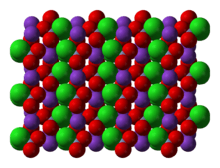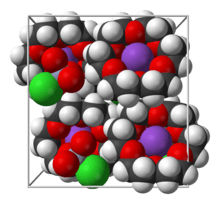Potassium trioxochlorochromate


Potassium trioxochlorochromate,[1] potassium chlorochromate,[2][3][4] Peligot's salt, or Péligot's salt is a chemical substance named after Eugène-Melchior Péligot.[5] Its formula is KCrO3Cl[6]
Peligot's salt is the potassium salt of chlorochromic acid (chromic acid where chlorine has replaced one of the OH groups). Peligot's salt can be considered intermediate between chromic acid and chromyl chloride.[5]
It is stable in air but in water, where it is soluble,[4] it can become hydrolysed. When under high temperature, Peligot's salt parts with its chlorine and produces chromic oxide.[5]
Potassium chlorochromate can be prepared from potassium dichromate, hydrochloric acid, and water. The substance may look like long orange-red crystals.[5]
Peligot's salt can oxidise the substance benzyl alcohol, a reaction which can be catalysed by acid.[7]
The structure of Peligot's salt has been redeterminated in 2002.[1]
(18-Crown-6)potassium chlorochromate

(18-Crown-6)potassium chlorochromate (1,4,7,10,13,16-hexaoxacyclooctadecane-k6O)potassium chlorochromate) or CrClO3 is a crystal structure that contains a K+ cation.[8]
Safety
Potassium chlorochromate can be toxic upon ingestion (may cause acute poisoning and kidney damage amongst other complications) or contact with the human skin (may cause eye burns, irritation, allergy, or ulceration), especially if inhalated.[9] Heating the substance, or mixing it with acids, releases chlorine[4] gas, which is also toxic.[9]
References
- 1 2 3 U. Kolitsch (2002). "Redetermination of potassium chlorochromate, KCrO3Cl". Acta Crystallogr. E58 (11): i105–i107. doi:10.1107/S1600536802019396.
- ↑ Synonyms Of Chemicals. Csudh.edu (2003-09-16). Retrieved on 2011-06-01.
- ↑ Merck & Co (1930). Merck's index: an encyclopedia for the chemist, pharmacist and physician. Merck & Co. Retrieved 1 June 2011.
- 1 2 3 Arthur Rose; Elizabeth Rose (1966). The Condensed chemical dictionary. Reinhold. Retrieved 1 June 2011.
- 1 2 3 4 Norm Stanley Colorful Chromium Compounds, 23 August 2002
- ↑ Glossary. Srb.npaci.edu. Retrieved on 2011-06-01.
- ↑ Özgün, B.; Pek, A. (1991). "Kinetics and mechanism of the oxidation of benzyl alcohol by potassium chlorochromate". Reaction Kinetics & Catalysis Letters. 43 (2): 589–594. doi:10.1007/BF02064733.
- ↑ Kotlyar, Sergei A.; Zubatyuk, Roman I.; Shishkin, Oleg V.; Chuprin, Gennady N.; Kiriyak, Andrey V.; Kamalov, Gerbert L. (2005). "(18-Crown-6)potassium chlorochromate". Acta Crystallographica E. 61 (2): m293–m295. doi:10.1107/S1600536805000085.
- 1 2 Susan Shaw; Susan D. Shaw; Monona Rossol (1 September 1991). Overexposure: health hazards in photography. Allworth Communications, Inc. pp. 122–. ISBN 978-0-9607118-6-4. Retrieved 1 June 2011.